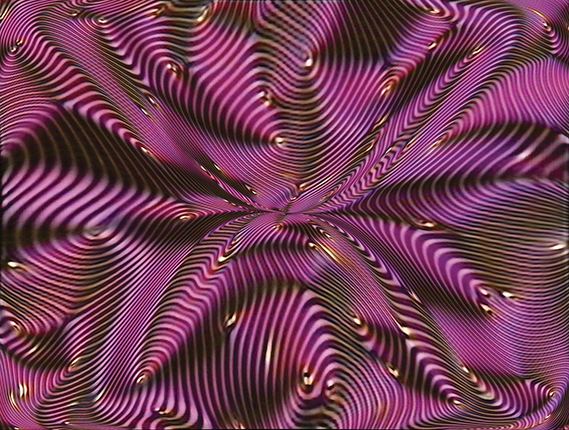Soft matter united
DOI: 10.1063/PT.3.3925
Most of life is made of soft matter, an intricate, dense tangle of organic molecules. The field of soft matter is usually organized into subcategories, the most important of which are liquid crystals, colloids, and polymers. Numerous textbooks address just one of those forms. But even in textbooks that embrace all sorts of soft matter, the various types are covered in separate chapters because their chemical composition and underlying physics are so different. Examples include Ian Hamley’s Introduction to Soft Matter: Polymers, Colloids, Amphiphiles and Liquid Crystals (2000), Richard Jones’s Soft Condensed Matter (2002), and Soft Matter Physics: An Introduction (2003), which I coauthored with Maurice Kleman.

Polarizing microscopic image of a cholesteric texture in liquid crystals.
INGO DIERKING, CC BY-SA 4.0

Liquid Crystal Colloids by Igor Muševič is an exception. It describes the fascinating physics of a hybrid soft matter formed by colloidal particles dispersed in a liquid-crystal environment. The principal difference between a liquid-crystal colloid and a conventional colloid is the occurrence of long-range interactions between the particles. Those interactions result from the elastic nature of liquid crystals and the anisotropy of their surface properties.

Muševič is a world-renowned experimental physicist who studies liquid crystals. Together with theorist Slobodan Žumer, he leads an enthusiastic and productive research group at the University of Ljubljana in Slovenia. Most of the book’s content stems from Muševič’s personal interests and research breakthroughs.
The book is written in an accessible, easy-to-follow style. Each chapter starts with a short abstract that introduces the reader to the content. The author uses his personal experience to explain difficult concepts in a clear and intuitive manner. Many chapters will be useful in graduate courses on soft matter.
Chapter 1 starts with the basic concepts of the liquid-crystalline state. The main feature of that state is the long-range orientational order of its constituent objects, typically rod-like organic molecules a few nanometers in length. As the material is warmed to a certain temperature range between a solid-crystalline state and an isotropic melt, molecules form a liquid crystal by packing parallel to each other; as they do so, they lose their positional order. Chapter 1 also introduces the order parameters characterizing the liquid-crystalline state; a unit vector called the director, which indicates the average orientation of the molecules; and a scalar that measures how well the molecules are aligned. Muševič describes the Frank–Oseen theory of the elastic response of liquid crystals to gradients of molecular orientation and concludes his opening chapter with an introduction to the fascinating world of topological defects, objects that bring the study of liquid crystals closer to the disciplines of superfluids and superconductors, cosmology, and particle physics.
Chapter 2 presents the “fruit fly” of the field, a spherical colloid with either perpendicular or tangential anchoring of the director. (Anchoring refers to a preferred orientation of the director with respect to the colloid’s surface.) When the spherical colloid is placed in an otherwise uniform liquid crystal, surface anchoring perturbs the surrounding director. Elasticity equilibrates those perturbations and establishes long-range interactions. Muševič describes liquid-crystal-mediated interaction potentials for several colloids, including Janus spheres and Janus rods. Chapters 3–6 deal with the rich physics of the individual and collective behavior of colloids in liquid crystals, from anisotropic Brownian motion to the creation of three-dimensionally ordered arrays of colloids. Chapter 8 covers an intriguing category of defects in a class of liquid crystals called cholesterics, topologically protected particle-like solitons that are stabilized by periodic modulations of the director.
Chapters 7 and 9 focus on inverted systems—droplets and shells of liquid crystals placed in an appropriate isotropic fluid. Dispersions of liquid-crystal droplets were studied intensively in the 1980s and 1990s, largely because they allow one to produce topological defects in equilibrium and their intriguing electro–optical properties lead to “privacy windows” applications. The field has recently experienced a renaissance because of exciting work from Muševič’s group that demonstrates how liquid-crystal droplets can be used as optical microresonators, microlasers, and optical fibers, all of which are often tunable by a modest electric field.
Liquid-crystal colloids is a growing field, and Muševič’s book presents a reasonably complete description of their equilibrium properties and static behavior. Dynamics, a field of study currently experiencing rapid progress, is less developed, though Muševič does cover Brownian motion.
As the foundation of flat-panel informational displays, liquid crystals have already secured their place among the most important technological innovations. Liquid Crystal Colloids presents an excellent account of why liquid crystals continue to inspire thousands of researchers around the world and shows us how much more we can expect from those wonderful materials. The book will be of great value to anyone who wants to explore liquid crystals, colloids, and their combinations and to those who just want to be introduced to some of the fascinating aspects of soft matter.
More about the Authors
Oleg D. Lavrentovich is a fellow of the American Physical Society and SPIE and a Trustees Research Professor at Kent State University’s Liquid Crystal Institute. His current research focuses on twist-bend structures, liquid crystals as nonlinear electrolytes, patterned liquid-crystal elastomers, topological defects and electro–optical effects, and living liquid crystals representing bacterial dispersions in chromonic nematics.
Oleg D. Lavrentovich. Kent State University, Kent, Ohio.
